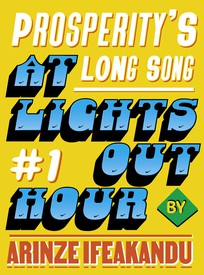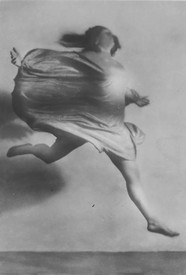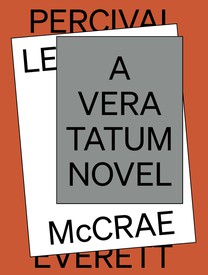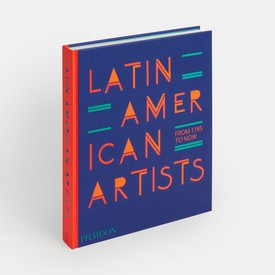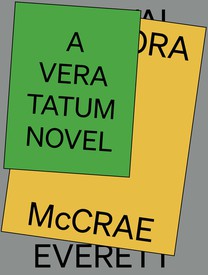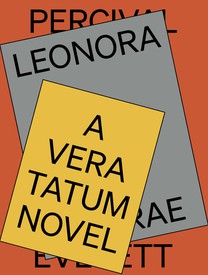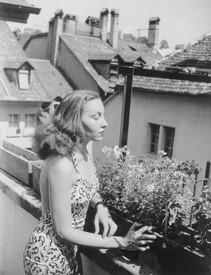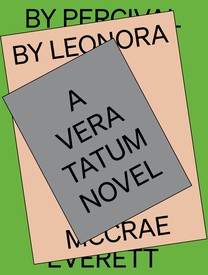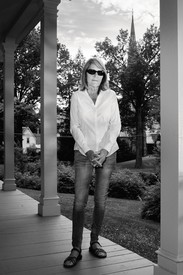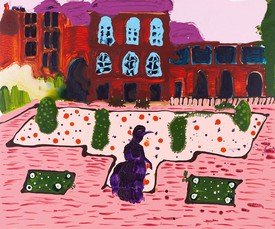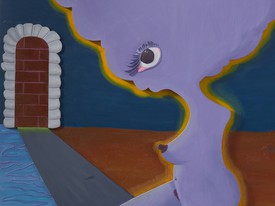
Francine Prose’s most recent novel is The Vixen (2022). Other books include Caravaggio: Painter of Miracles, Peggy Guggenheim: The Shock of the Modern, Reading Like a Writer, and Lovers at the Chameleon Club, Paris 1932. The recipient of numerous grants and awards, she writes frequently about art. She is a distinguished writer in residence at Bard College.
He has come to Naples to paint clouds. But since his arrival, weeks ago, he finds that he can paint anything but clouds. Actually, he’s painting quite well, with confidence and with the necessary and sincere spiritual devotion. But he cannot do the one thing—one could even say, the only thing—for which the brothers of the Confraternity of the Precious Blood of Jesus have brought him here from Venice: the reason why he was hired.
The sweet face of the Virgin melts onto the wall and the saints cluster around her. Even Saint Peter of Verona, with the axe of his martyrdom still buried in his head—an odd touch for a dining room fresco, but that’s what the duchess wants—seems to have been animated by the painter’s touch. The most gravely wounded holy men and women leap from his palette. The apostles seem to have been hiding beneath the surface of the plaster, just waiting for the tap of his brush.
But the clouds he paints look like lumps of raw dough, like the poisonous icing with which the mad baker of San Polo poisoned his customers, like the cloyingly perfumed fur of mangy lap dogs, like the filthy snow that covered Venice during the freak winter when so many died, like lint, like the clouds his five-year-old son drew that day . . . best not to think about that.
He has come here to do two paintings, one for the dining room in the palazzo of the grand duke, the other for the altar of the chapel of the Confraternity of the Precious Blood. And it’s all because of his reputation for painting clouds. If the grand duchess had her way, she would have clouds, clouds, nothing but clouds, because (so the painter has been told) clouds are the fashion of the moment in the decoration of the most stylish palaces and villas. Everyone, by which the Neapolitan men mean their wives, everyone wants them. But because the grand duke is devoutly religious and intensely conscious of his high position in the confraternity, the duchess has agreed to cover the bottom quarter of the wall with saints and martyrs witnessing the Ascension of the Virgin Mary. The duchess wants to see the Madonna rising into the pink, violet, and pale-blue sky that spans the walls and the vast domed ceiling. She wants to entertain her guests beneath the pastel sky dotted with the summer-day clouds that she, her husband, and their friends imagine is the weather in heaven.
The altar in the confraternity’s chapel will have towering thunderclouds lightly weeping above the Deposition, bathing the dead Christ and the mourners in warm tears of consolatory rain. The painter knows everything that can be known about the punctured ankles of Jesus, about the hair of the Magdalene, about where the donors will kneel, though the number and identity of the donors will be unclear until the confraternity makes its final fiscal calculations. He knows which of the mourners will carry exactly how much of the weight of the dead Christ. And he puts all that into the painting.
But when he reluctantly shows his half-finished work to the brothers of the confraternity, men who are used to getting what they pay for, their eyes drift toward the greasy, pitted black sky over the Deposition. The grand duke drags him into his dining room and grabs him by the shoulder and makes him look at the garish pinkish-violet-blue heavens with nothing to soften the Virgin’s ascent, and asks the painter, “What is this shit? You think my wife wants to look at this?”
All the brothers are rich, all expensively dressed. Even the older ones are still handsome and vital. When the painter shows them what he has done, the brothers of the confraternity shrug and say nothing. They are paying the painter extremely well, and they aren’t stupid.
Naples is full of artists who can draw the Virgin ascending, the corpse of Jesus lowered from the cross by the grieving mourners who, in three days, will be getting a surprise. A nun in a crumbling Spaccanapoli church has painted the apostles with such lifelike clarity that her altar was taken down, because the congregants were so busy trying to figure out how they knew Matthew, Mark, Luke, and John that the priest couldn’t get them to focus on the body and the blood.
The painter has been brought here from Venice because he can paint clouds that turn the inside into the outside, the indoors into the outdoors, clouds that can make people feel as if the ceiling had been peeled back and the years scraped away, and that they are children again, children lying in a field, with nothing to do but watch the clouds shift shapes and talk about what they see.
Ever since the painter came to Naples, he’s painted clouds and scraped them out, wet down the plaster, painted more clouds and rubbed them out, leaving smoky, oily, stained skies: heaven after a disaster. He cannot tell his employers that he hates Naples, which everyone loves and which he is supposed to love. There is no one he can tell how homesick he is for his family, for his wife and child, and for the high clouds of Venice. In Venice you twist through a crooked alley and emerge onto an open piazza crowned by a sky in which the high clouds are waiting to greet and reward you. When he looks up at the sky from the dark, narrow streets of Naples, he sees laundry and more laundry.
The painter has always been fascinated by clouds. His siblings and school friends saw sheep turning into angels into birds, but he saw biblical scenes, scenes of battle, and occasionally the faces of his neighbors, though he told no one whose face he’d seen because it rather soon (and rather dramatically) became clear to him that when he saw a face in the clouds, it meant that the person was going to die, often within weeks or even days. The furniture-maker across the street, the pretty maid who churned the butter. It wasn’t a gift that anyone would want, but he had it, and he had no idea how to get rid of it, except to avoid looking at the sky, which was impossible, especially for him.
He has told no one, not even his wife, about this, and he has tried, throughout his career, to paint clouds in which no one can see anything but masses of water and light and air. In his clouds people see one moment in time, no more or less, and certainly not the faces of the doomed.
As a boy, he covered the walls of his room with clouds and was sent to study with the master painter in whose studio he, though still a boy, was given the job of adding the clouds above the holy scenes and behind the figures in the master’s portraits. All the boys in the master’s studio, and now all the boys in his own studios here and in Venice, all have the same story: they’d painted or drawn on the walls, and someone noticed.
Like many artists, the painter is superstitious. In Naples he cannot stop feeling that the clouds have abandoned him. He blames this on two incidents—two that he can remember.
One: he took his mistress, a married woman, to a field outside his childhood village, near Padua. Afterwards, they lay on a blanket, and she was saying something, saying she loved him and wanted him to abandon his wife and she could leave her husband and they could run away together, or maybe she was saying that she didn’t love him and they had to end it. He didn’t know what she was saying, because he was seeing her husband’s face in one of the clouds.
He didn’t want to see it, he wished the man no ill, in fact he often felt guilty for having seduced the man’s wife. Nor did he want the husband to die, because he wanted things to stay as they were.
His mistress began to weep, because she had been saying something close to her heart, and he hadn’t listened, he’d been looking at the clouds. This seemed unfair, because part of the reason she’d fallen in love with him (though she denied it) was on account of his fame as a painter of clouds.
Days later, her husband died suddenly, of apoplexy, and, now, in her guilt and grief, she has ended their affair.
Two: his five-year-old son has inherited his skill in drawing and painting. The child loves his father, loves to imitate his father, thinks his father is a god, so perhaps that was why, not long before the painter left Venice, the boy drew a sky full of clouds, a childish version of what his father might do, except that he included a remarkable likeness of his father’s face in one of the clouds. Shocked, the painter slapped his son, whom he adores and had never hit before. The boy ran away, sobbing, crying for his mother. Now, he thinks, the boy will never become an artist, the boy will never love him as much or as innocently as he once did. The painter doesn’t want to think how much of his gift has been passed down to his son, and whether the child drawing him in the clouds means that he will soon die.
Since then he has come to feel that he has angered the clouds and they have withdrawn their support. He has no trouble reconciling this pagan belief with the fact that he is a Christian and believes that Jesus died for his sins and was resurrected to redeem mankind.
In Naples, the painter has taken another lover, a boy of sixteen who works in his studio. He loves the boy’s perfect body, but there is something else. The boy believes that every problem has a solution. It is not just because he is young. He is not afraid, not haunted, not ashamed. He is not in the least superstitious.
The studio assistant has been to Venice and seen the painter’s work, and he is conscious of (and discreet about) the fact that something is wrong with what the painter is doing—trying to do—in Naples. The boy’s sensitivity, kindness, and discretion are among the qualities that the painter loves. The boy believes that the painter’s problem with clouds is something that can be solved.
The boy sends the painter to a doctor who applies leeches to the sides of his head and prescribes a course of tonics. The painter agrees, partly because he loves the boy and who knows, it might help. When he finishes the last drop of tonic, the painter (who has been pleading illness) returns to the grand duke’s dining room and reapplies himself to the job.
The clouds he paints look like fingerprints, like smears of bird shit stuck to the wall. Why would the Virgin want to trade the green earth for that thick white poison?
The boy, the studio assistant, comes from Naples, which gives him a certain authority, even though he is young. Now he tells the painter that there is one more thing he can try. A crazy idea, but sometime the craziest ideas are best.
The painter is at a stage of love at which he is enchanted by the boy’s crazy ideas. How beautiful he is, how innocent, how young.
The boy suggests a pilgrimage to Cumae, where, some have said, it is still possible to communicate with the ancient prophetess there, the Sybil, to ask for her advice. Though the painter is not well educated, not nearly so well educated as the boy, he knows who the Sibyl was. She’s been painted by Raphael. Leaning on one elbow, the boy is naked when he tells the painter: before Aeneas traveled to the underworld to see his father, the Sibyl warned him that the difficult part would be returning to earth. Does he want the painter to say that it will be hard for him to leave the boy and return home to Venice?
The painter says he has no desire to visit the underworld, thank you very much, and the boy says it’s not like that, there is a cave near Cumae, if you ask the locals they will tell you where it is. By the time the world lost track of the Sibyl, she was a thousand years old; she’d asked for immortality but had forgotten to ask for perpetual youth. For centuries she was reduced to a cracked whisper, a wisp of smoke, a fragment of bone and hair; all that remained of her was contained in a jar. Obviously the jar no longer exists, and there isn’t much to see where the entrance to her cave is believed to have been, but sometimes people go there and hear voices. The boy knows a man who went to Cumae and came back, problem solved.
The painter wonders about this man. Should he feel jealous? There’s something the boy’s not saying. Still, he likes the idea, especially if the boy goes with him. A day in the country sounds sweet.
The boy reminds him that Naples is a city of thieves. If they both go away at once, chances are that they will return to a bare studio, with all the paints and brushes stolen. He will stay and guard the studio. It’s a simple trip. Three hours. The painter can go and return in a day. By now the painter can’t back down, for fear of admitting that the only reason he wanted to go was to travel with the boy.
The boy tells him the story about the Sibyl offering her books of prophecy to King Tarquin. Each time he refused the books, she burned a third of them and offered him the remaining books at the original price, until he got scared and gave in and purchased the last three books at the price he would have paid for nine.
What did the books foretell? the painter asks. No one knows, says the boy. Maybe the fall of Rome. The painter has no interest in the fall of Rome, that is, ancient Rome, but he does enjoy the thought of his rivals, the Roman painters, disappearing along with their city. Even more, he likes the idea of the Sibyl as a hard bargainer, like himself. He asked and got the second-highest fee ever paid a Venetian artist, plus travel to Naples and expenses. Maybe he was greedy, maybe that was why everything has gone wrong.
The boy says he thinks there’s a cave in Cumae but it won’t be much to see.
The painter thinks it’s worth a try. He is, after all, superstitious. Perhaps the Sibyl can tell him why his special talent has failed, and how he can recover it. If not, it will make a good story to tell when he goes back to Venice and will need to charm lots of people in order to repair his reputation and his career, if that is even possible. Word travels quickly, and his patrons there will have heard the gossip from Naples. His best hope is to turn his unhappiness here into a story about the triumph of Venice over Naples as a place of inspiration.
He leaves for Cumae in the morning. It’s a perfect early-spring day. The painter loves the carriage ride, the shortcut over the mountains and then down into the coastal plains instead of going the long way along the coast. There are purple and orange flowers, shockingly bright, dandelions scattered and clumped in the meadows. He looks out the carriage window as they pass some moss-covered stone structures, boulders heaped in a purposeful way. Probably Roman. Ruined temples, he decides. Dust to dust. All of them will end that way, their sorrows on earth forgotten, and for a moment death seems less frightening, almost a comfort.
He asks the driver to take him to the cave of the Sibyl, and it goes surprisingly smoothly: someone gives the driver directions and then someone else gives him more directions. Everyone knows what he’s talking about.
Does he really expect to hear something meaningful—if he even finds the Sibyl’s cave? Or does he think he will feel something? Of course not. No, not really. He likes being out in the country, where for a while he can forget his dilemma, his life’s work: painting clouds for thugs. There are clouds above the dry rolling scrubland but they have nothing to say to him. It’s as if they’re speaking a different dialect from the Venetian that only Venetians understand. Oh, why did he ever leave home?
The journey ends beside a field. The driver points across the field. There. Over there.
The painter says, Are you sure?
Several people along the way tell him Yes, this is it, and the goatherd who comes by says Yes, there it is, and points into the same field. It’s a garbage dump, lumpy with hillocks of broken crockery, melon rinds, egg shells, mattresses leaking hay, table waste, rags, and worse. The painter isn’t squeamish, but he’s not going to wade through a field of garbage to hear nothing from a spirit who doesn’t live in a cave that doesn’t exist. He’s at once disappointed and relieved.
Did the boy know about this? Is this some kind of practical joke, a cruel childish prank? The painter chooses to think not. He and the boy will laugh about it. The painter will say that he likes stories about failed odysseys and pilgrimages. He has always wanted to paint the fourth wise man who got lost on the way to Bethlehem and never found the manger. He’s been told he could never sell it, but still, maybe the boy will pose. The boy will say he’s sorry, his information about the Sibyl’s cave was incorrect, and they’ll laugh again. The boy was trying to impress him with his knowledge of the area, which the painter finds charming. Flattering, even.
On the way back to Naples, the painter stops the driver. He sees something beside the road. Two children, clearly a sister and brother, beautiful, both with thick mops of curly blond hair. They’re folding laundry. Laundry! It’s like a pas de deux, carefully choreographed, each holding the corners and crossing and coming together, a ballet that turns the winter quilts into neat packets. He watches them fold a large white cloth.
Suddenly, he realizes: That’s what he wants to paint. Laundry was the secret, hiding in plain sight above the dark narrow streets of Naples. Cherubs unfurling a banner above the head of the Virgin, angels offering a soft, violet-gray shroud to wind around the broken body of Christ. He knows how he will do it, and just as suddenly he is sure that his cherubs and banners will put an end to the Neapolitans’ shallow and fleeting taste for painted clouds.
He can hardly wait to get home and start painting celestial laundry. He makes the driver push the horse hard, they pass oxcarts, charge through the midst of flocks and herds, take risks. He hurries to his studio, where propped against his easel is a note from the boy saying to meet him in the grand duke’s dining room.
He knows what he will find there, or maybe later, after the fact, he thinks he knew. He finds the boy alone in the dining room that the painter has been trying to paint. In the hours during which the painter has been gone, the boy has covered the walls and ceiling with the greatest paintings of clouds that the painter has ever seen, better than he could have done because the boy’s clouds seem to promise a bright, sunny future. Miraculously, the boy has also found time to complete the sky above the Deposition from the Cross in the chapel of the Confraternity of the Precious Blood. The boy asks: does the painter want to see it?
The painter feels dizzy. He wants to sit down. He’s trying to remember a legend he heard about some angels who came and finished a painter’s work in the middle of the night, but he can’t recall any of the details.
The boy says that he hasn’t meant to poach on the painter’s territory. It’s just that he was stuck here, bored, with nothing to do. He missed the painter, he wanted to do something to show his gratitude. His affection. He wanted to speed up the work. He hopes the painter isn’t angry. He doesn’t intend to take credit. No one was here in the dining room, the family was away, the palace has been empty, no one saw him paint, and he will gladly say (and take the truth with him to his grave) that the clouds are the painter’s work.
After all, it’s the painter’s commission. The boy is just his studio assistant. Nothing has changed, really, nothing has changed. But it seems to the painter that something important has happened. The Sibyl has told him something, prophesied something, without his having found her.
This is what she would have said: This is how it always happens. The student completes the work of the master when the master turns his back, or the master is old or ill, or when the master has gone off looking for the Sibyl of Cumae. He did it to the master to whom he’d been apprenticed, in whose studio he’d worked, painting clouds, from whom he’d learned, and whom he’d loved and then trampled on his way to . . . this. It’s a law of nature. It cannot be avoided.
Out of affection, and for balance, he puts his hand on the boy’s shoulder as he stands and considers the painted clouds around and above him, the dome of the sky pressing lightly down on the apostles and saints. He sees himself in one of the clouds, his young wife, his little son, this boy he loves, his former mistress, his patrons and his painter friends, each face clearly visible in the shape of a cloud as the Virgin floats upward, riding the current, bell shaped, ascending like a diving bell in the air, arms outstretched, palms down, slowly rising toward them.
“The Lives of the Artists I: The Master of the Prophetic Clouds” by Francine Prose. Copyright © 2018 by Francine Prose. All rights reserved.
Read “The Lives of the Artists II: Prodigy,” “The Lives of the Artists III: Muse X Two,” “The Lives of the Artists IV: Rock Baby”
